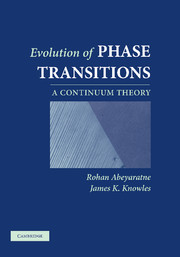Book contents
- Frontmatter
- Contents
- Preface
- Part I Introduction
- Part II Purely Mechanical Theory
- 2 Two-Well Potentials, Governing Equations and Energetics
- 3 Equilibrium Phase Mixtures and Quasistatic Processes
- 4 Impact-Induced Transitions in Two-Phase Elastic Materials
- Part III Thermomechanical Theory
- Part IV One-Dimensional Thermoelastic Theory and Problems
- Part V Higher Dimensional Problems
- Author Index
- Subject Index
2 - Two-Well Potentials, Governing Equations and Energetics
Published online by Cambridge University Press: 12 August 2009
- Frontmatter
- Contents
- Preface
- Part I Introduction
- Part II Purely Mechanical Theory
- 2 Two-Well Potentials, Governing Equations and Energetics
- 3 Equilibrium Phase Mixtures and Quasistatic Processes
- 4 Impact-Induced Transitions in Two-Phase Elastic Materials
- Part III Thermomechanical Theory
- Part IV One-Dimensional Thermoelastic Theory and Problems
- Part V Higher Dimensional Problems
- Author Index
- Subject Index
Summary
Introduction
In this chapter, we assemble the basic field equations and jump conditions for a one-dimensional, purely mechanical theory of nonlinear elasticity; although thermal effects will be omitted, inertia will be taken into account. The theory presented here is general enough to describe nonlinearly elastic materials that, under suitable conditions of stress, are capable of existing in either of two phases. As we shall see, a key feature of this theory is that the potential energy of the material, as a function of strain at a fixed stress, has two local minima. The associated constitutive relation between stress and strain will then necessarily be nonmonotonic, possessing a maximum and a minimum connected by an unstable regime in which stress declines with increasing strain.
Experiments that provide the motivation for the theory about to be developed fall into two categories. The first of these involves slow tensile loading and unloading of slender bars or wires composed of materials such as shape-memory alloys. The model to be constructed to describe experiments of this kind is one of uniaxial stress in a one-dimensional nonlinearly elastic continuum, and the processes to be studied for this model are quasistatic. The stress-induced phase transitions in such experiments occur in tension, so the two minima in the potential energy density occur at positive – or extensional – values of strain, as do the extrema in the stress– strain relation.
- Type
- Chapter
- Information
- Evolution of Phase TransitionsA Continuum Theory, pp. 19 - 31Publisher: Cambridge University PressPrint publication year: 2006



